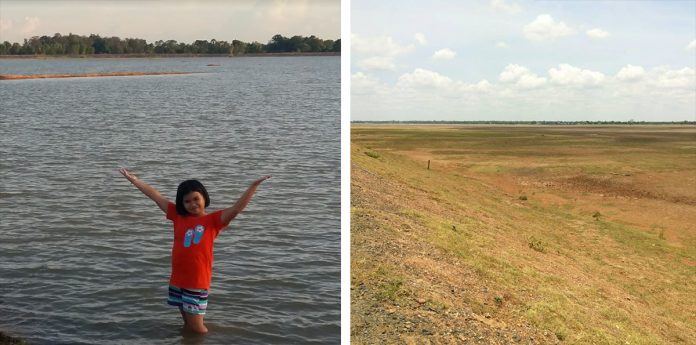During past wet seasons, boat restaurants filled with tourists puttered along Bueng Kraton Lake, while holidayers took selfies by the water. But today, the lake has disappeared entirely, dried up by an ongoing drought. The boat restaurants are wedged in dried mud, and the visitors gone.
The 10,000 rai (1,600 hectares) of nearby farms, which depend on the lake for water, are struggling.
“This dry season is especially long. There’s no rain for the crops anymore, and the rice plants are dying where they stand,” Anukul Tongkam, 47, a local farmer said.
Anukul said he recalled Prime Minister Gen. Prayuth Chan-ocha’s promise to tackle the drought when he visited Bueng Kraton on Aug. 21, 2018.
On Saturday, agriculture deputy minister Capt. Thammanas Prompao visited Phayao, where July’s total rainfall numbered 193 millimeters, compared to 600 to 700 millimeters in previous years.
This year’s rainy season has seen about 30 percent less rain compared to the past, resulting in about a 50 to 70 percent drop in water levels in northeastern water basins, said Seree Supratid, director of the Climate Change and Disaster Center at Rangsit University
Seree attributes the drought to two factors: less rain this year, and unregulated water usage in agriculture.
Tackling agricultural water use is more important than regulating water use in cities, Seree says, since agricultural use accounts for 70 percent of national water use.
“Too much water is being released for agricultural use. This water is also not being tracked,” Seree said.
Locals say they haven’t seen the Mekhong so dry in five decades, with connected tributaries slowing to a trickle.
“I’ve never seen such a drought in 50 years. This is supposed to be the wet season,” said Kattaya Oon-klom, 54, a farmer of Nakhon Phanom who relies on the Songkhram River for farming.
By the Mekhong in Loei, fishermen are struggling to catch anything in the shrinking river.
“Normally in July the Mekhong would be brimming opaque,” Kamol Pongsri, a fisherman said. “But now it’s unusually dry. Every day, I think it hovers between 50 centimeters to a meter. Our boats are grounded.”
A bulletin released by the Royal Irrigation Department on Monday recorded low water levels at Ping River in Chiang Mai, Wang River in Lampang, Yom River in Phrae, Nan River and the Chao Phraya River in Nakhon Sawan, Chao Phraya Dam in Chai Nat, Pa Sak River in Ayutthaya, Mun River in Ubon Ratchathani, and Chi River in Yasothon.
Local dams are being drained in dry areas like Buriram. Meanwhile, in Ang Thong, Huai Phai and Sawaeng Ha subdistricts are alternating access to agricultural water, the bulletin said.
The 447 dams and reservoirs nationwide are about 48 percent full, the bulletin also noted.
“The effects will be the harshest in the northeast and north,” Seree said. “And if rain doesn’t fall by August and September, there will be worse repercussions since we won’t have any water supply squared away.”
Agricultural minister Thammanas has said that the government will try to stimulate rain through artificial rain-making.
As of Thursday, about 70 percent of the 16.21 million rai (2,593,600 hectares) of rice fields in the country have been sown with this season’s crops. A rainy spell early July provided much-needed water in some areas of Thailand.
Samit Thammasorot, president of the Foundation of National Disaster Warning Council, confirmed on July 15 that Thailand should brace for a shortage of rain from July through Sept., caused by a lack of cool air flowing from China. The drought will affect not only Thailand, but also India, Pakistan, and Myanmar.




